By Roland Murphy and CJ Jorgensen for AZBEX
The 200-plus registered attendees at Wednesday’s BEX 2024 Public Works Conference were treated to discussions of diverse needs, common approaches, mutual cooperation and far-reaching return on investment by a series of panelists discussing public infrastructure across metro Phoenix and around the State of Arizona.
Emcee Cassie Wells, CEO of Modern Business Development, welcomed the audience to the Desert Willow Conference Center, outlined the afternoon’s program, thanked the sponsors and wasted no time getting into the meat of the event and introducing BEX President and Founder Rebekah Morris.
Economic Drivers and Capital Improvement Programs
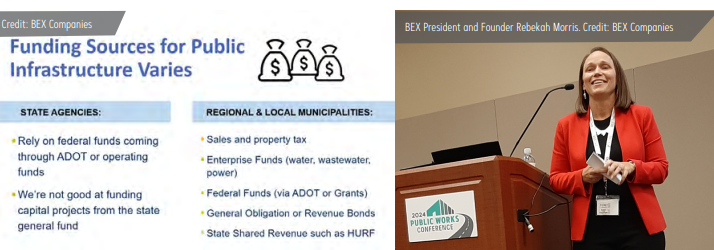
Morris’ presentations on what drives development in Arizona in public capital improvements have led to her becoming a highly sought-after speaker to Architecture/Engineering/Construction and commercial real estate audiences in the state.
She began, as she normally does in her major event presentations, with a recap of the construction drivers in Arizona (population growth, total employment, construction employment and overall construction activity), and then narrowed her focus to the 19% of the overall construction market made up of public infrastructure investment. She explained the funding funnel and process flowing from federal sources like grants and allocations and state and local sources like sales and property tax, enterprise funds, bond measures and shared revenue sources like the Arizona Highway User Revenue Fund.
She then dove into the meat of the material that would cover the rest of her time on stage: Capital Improvement Plans around the state, most particularly the Top 10 programs, their most prominent projects and their year-over-year change from previous CIPs.
Phoenix leads this year’s CIP roundup with a total program of $12.295B, an increase of 12%. Maricopa County was at the bottom of the Top 10 at $1.003B, having decreased 3.25%.
While Mesa’s CIP showed consistency at $2.11B, a 0.74% increase, and Chandler was moderately larger at $1.29B and 7.47%, other municipalities showed significant changes.
Along with Maricopa County, two other jurisdictions saw decreases, both of which could be termed significant. Scottsdale dropped 12.86% to $2.234B, and the Arizona Department of Transportation went down 15.19% to $8.113B, which still kept it in the Number Two position behind Phoenix.
Most impressive, however, were the municipalities showing major increases. Tempe’s CIP quietly rose 29.83% to $1.96B. Gilbert soared up 32.21% to $4.251B, and Surprise—even though it was Number Nine for overall dollar amounts—rocketed up 42.75% to $1.203B.
Morris pointed out that, in aggregate, the Top Ten programs increased by 4.32% and reminded the audience not every program increases every year.
Following a rapid but thorough summary of leading markets’ top projects, Morris made sure attendees were aware of the following ongoing considerations:
- She believes 2024 will be the top year for public infrastructure investment, particularly as federal investments, like the American Rescue Plan Act and Infrastructure Investment and Jobs Act, spending wind down. “I like to say our municipalities are very wise. They like to use one-time money for one-time expenditures… Generally, capital projects do very well in that environment. Those are coming to an end.”
- Bond measures consistently and persistently face challenges in winning voter approval. “Instead, what we see is something that is not subject to voter approval, maybe like a sales tax measure or water user fund increase. Something like that is a lot easier when you only have to convince seven people on a city council versus however many voters your municipality has. That’s an easier sell. That’s where we’re getting our funds for capital projects.
- State-shared revenues will continue to decline.
- The industry has largely been lucky in terms of budget. Municipalities have enjoyed both a torrent of federal funds and increases in revenue that let them absorb major spikes in construction costs. That is also coming to an end. “We can’t just absorb 20-30-40% cost increases on an annual basis. That’s just ridiculous. You’ve got to give somewhere, and I would say our attitude or environment for passing along large budget increases is probably not going to go great moving forward.”
- Dedicated revenue, such as enterprise funds, are a strong and continuing positive provider for applicable projects, such as water and wastewater.
Morris then segued to matters of funding, including the Proposition 479 transportation sales tax renewal in Maricopa County and the Proposition 486 transportation excise tax measure in Pinal County, both of which are on the November ballot.
She also touched upon the municipal and K-12 education bond requests coming before voters all around the state and promised a thorough overview of those issues in the near future.
Top Public Owners Panel 1: Gilbert, ADOT, Phoenix
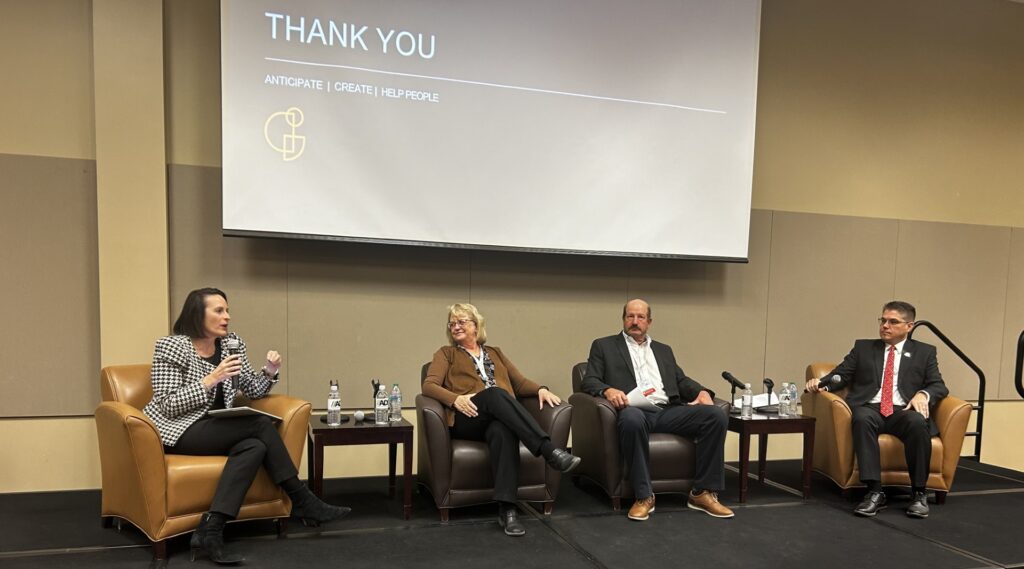
The first panel of the day brought representatives from three of the Top Ten CIP project leaders to the stage. The panel, moderated by Kitchell President & CEO Wendy Cohen, was made up of:
- Steve Boschen: Assistant Director – Infrastructure Delivery & Operations for ADOT,
- Eric Froberg: City Engineer for City of Phoenix, and
- Susanna Struble: Town Engineer and CIP Manager for the Town of Gilbert
The panelists were each given a few minutes to discuss programs, activities and challenges facing their individual agencies and departments, then Cohen wasted no time diving into the question-and-answer portion of the session.
While each of the panelists had addressed cost increases as a major challenge, Cohen asked what other challenges they foresee as they move forward with implementing their CIPs over the next five years.
Struble answered first, saying she was concerned with availability of resources, both internal and external, particularly having enough people to deal with issues as they arise. She also is concerned with issues of funding and cost escalation.
Boschen’s major issue is providing services at a reasonable cost to “Greater Arizona.” He said there is not much difficulty finding contractors who want to work in the major metro areas, but, “It is a real effort to get people out to remote areas. Statewide Arizona is real and we also have roads there. We need to fix them.”
Froberg said the major challenge for him is managing expectations, particularly when it comes to deadlines, timelines and turnaround of efforts, especially within the confines of mandated procurement process.
Cohen then turned to labor issues, asking how the availability of skilled labor is impacting the panelists’ operations and what they are seeing in their workloads.
Boschen started the responses by saying it is vital to increase Science Technology Engineering and Math-directed education curricula in high school and promote technical trades to increase the pipeline of workers.
Struble said retirement is having an impact, as businesses and agencies lose institutional knowledge. She recommended expanding mentorship programs to help pass along the knowledge seasoned workers have picked up over their years of experience.
Froberg said that as federal funding sources reach the end of the cycles by which they need to be used, there is added pressure to get more work completed ahead of deadline while using the same-sized labor pool. “The amount of skilled labor hasn’t increased. They’re just all busy… We’re really just all competing for the same skilled labor.”
Several attendees were seen to lean forward in their seats when Cohen moved to her next topic. While many of the projects advanced in agencies’ CIPs focus on new projects and expanded development, what is being done to address the need to maintain and remediate the impacts of deferred maintenance around the state?
Struble said Gilbert “is in a unique situation” when it comes to deferred maintenance as it transitions from looking at new development to components that were put in place as many as 35-40 years ago. “We only have 15% of our community that’s left to grow, but our infrastructure is all aging,” she said. “We are very grateful that our management and our financial team has looked at that and have set aside a lot of money to deal with that.” She added the caveat, however, that those monies had been set aside at a lower cost, before the current degree of cost inflation, and that there would still be significant challenges.
Boschen drew laughter when he promised the audience ADOT was using all the duct tape and baling wire in its inventory to hold roadways together. Turning serious, he said it is essential to expand pavement preservation and maintenance programs. He said if pavement replacement is only performed every 50 years, asphalt is not going to last. “In terms of deferred maintenance, I think we’re doing the best we can right now, but the funding is not there to do what we should be doing, and that’s meaningful pavement rehab.”
Froberg explained that Phoenix put $500M toward accelerating pavement maintenance a few years ago. “The trick for us now is to not then ignore those roadways for the next 50 years. Okay, we got many of them back to a satisfactory condition. Now it’s, ‘Where does the funding come from to keep it that way and how do we make it go forward?’” He added the City is trying to balance how to continue working to serve expansion without ignoring existing areas.
Cohen said it can be hard, politically, to fund deferred maintenance when new resources are needed to provide for growth. “Candidly,” she said, “that (growth) is what voters often will support. Deferred maintenance is a little bit harder to sell.”
Boschen got the biggest laugh of the day, along with nearly an entire room full of heads nodding in agreement when he replied with, “You don’t ‘ribbon-cut’ maintenance.”
Top Public Owners Panel 2: Maricopa County, Glendale, Scottsdale
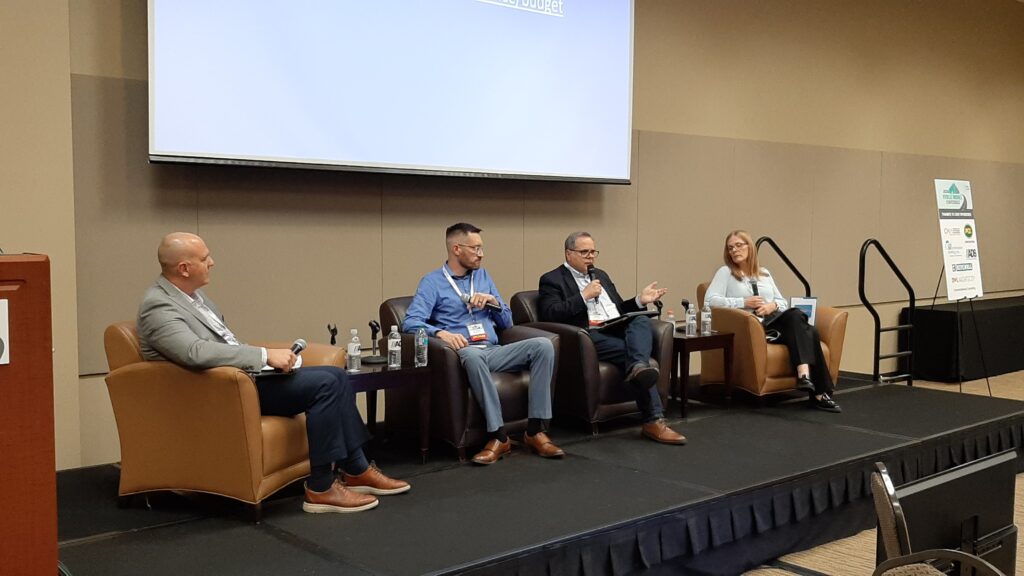
The Public Works Conference featured three more panelists representing public owners in its second panel of the day.
Moderated by Dan Menghini, the Municipal Market Business Unit Leader for Chasse Building Team, the panel featured:
- Seth Bouman: Sr. Architect – Design Division Manager for Maricopa County,
- Eddie Garcia: City Architect for the City of Glendale, and,
- Alison Tymkiw: City Engineer for the City of Scottsdale.
After each panelist gave an overview of activity in their respective jurisdictions, Menghini led them into the question-and-answer portion of the discussion.
The first question Menghini posed revolved around the factors that drive decisions in how a municipality will choose a delivery method.
Bouman was the first to answer, stating his division’s leadership prefers to use the design-bid-build method when applicable. For some projects, however, it becomes more complicated, “Once we get into the $15M range, we start to have the conversation about having a Construction Manager at Risk.”
Tight deadlines and the involvement of multiple departments were also factors in using the CMAR method.
Garcia mentioned that Glendale prefers to use CMAR for vertical projects and design-bid-build for horizontal projects.
Garcia also mentioned he believes Glendale will “eke” its way into using design-build.
Tymkiw stated Scottsdale has leaned more toward a CMAR selection process due to COVID, construction inflation and supply chain issues.
She believes that as time progresses, Scottsdale will regain the more balanced delivery approach it had prior to the pandemic.
Menghini then asked the panelists if they had any personal favorite delivery methods.
Tymkiw answered by saying that CMAR was the most commonly used in Scottsdale, but it’s not immune to issues. She referenced having to switch from CMAR to low-bid due to being unable to reach an agreeable Guaranteed Maximum Price due to cost inflation on many projects.
Garcia agreed, saying CMAR is generally the baseline. He proceeded to instill the idea that it’s not the delivery method that matters; rather, it’s the behavior and chemistry of the team that makes a project work.
He used an analogy that the delivery method is merely a vehicle. If the chemistry of the engine is off, it simply won’t run.
Menghini proceeded to ask the panelists the traits they value the most from their architects, engineers, consultants and general contractors.
Bouman answered first, saying it’s noticeable when teams listen to the needs of the County and feedback, while also being adaptable.
Garcia reinforced the idea that behavior and chemistry are a large component, saying, “You really don’t get paid to get along with each other, but man, it’s nice when it happens.”
Tymkiw said that the most important thing she looks for is someone who will be proactive and actively look for solutions.
Menghini asked the panelists what challenges they face and how they overcome them.
Tymkiw believed the budget is easily the biggest challenge Scottsdale faces. She said Scottsdale is trying to accommodate current difficulties by finding more efficient ways to handle projects.
She mentioned Scottsdale will be testing a few transportation projects by initially putting them out as “design-funding only.”
Bouman referenced deadlines as a big challenge. The earlier projects can be worked on, the better. He also explained that individual departments need to know as many details about a project as possible and prepare them for consideration early.
Public Works Investment and Economic Development
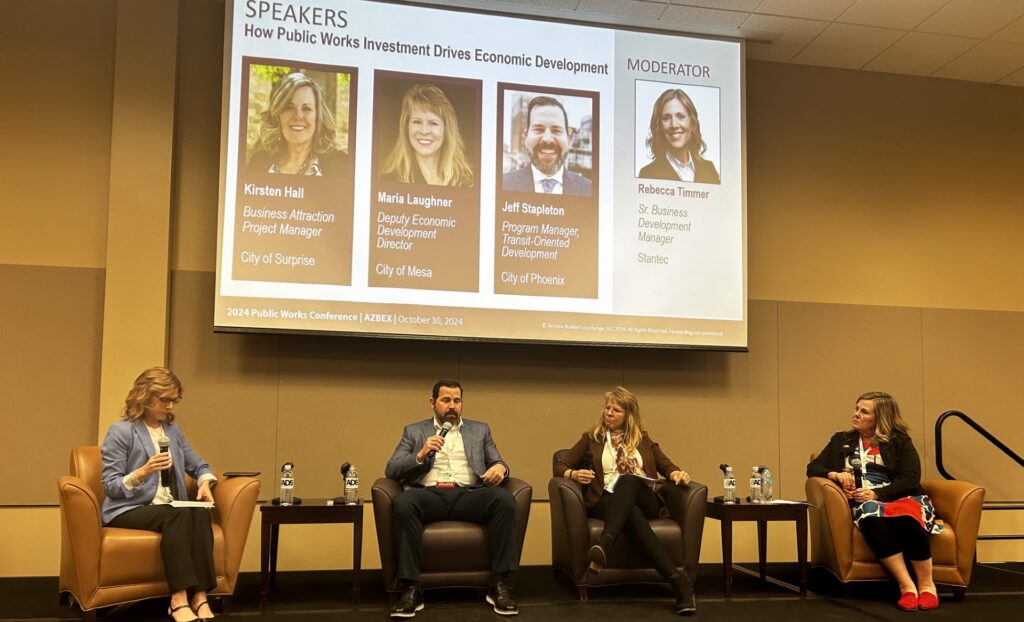
The last panel of the day dealt with how public works investment drives economic development in both the public and private sectors. Moderator Rebecca Timmer, Sr. Business Development Manager at Stantec, moderated the panel and introduced the members:
- Kirsten Hall: Business Attraction Project Manager for the City of Surprise
- Maria Laughner: Deputy Economic Development Director for the City of Mesa, and
- Jeff Stapleton: Program Manager, Transit-Oriented Development for the City of Phoenix.
Timmer began the question-and-answer discussion by asking panelists to quickly give their views on how public investment drives economic and real estate development.
Hall said it serves as a force multiplier to encourage private investment and gave the example of improved roads providing for more retail and industrial growth.
Laughner gave a type of, “If you build it, they will come,” response, saying the hope is that investing in roads, parks and similar public projects will spur new residents, employers and service providers to move to the community and fuel the tax base.”
Stapleton mentioned one of the most significant public transportation investments fueling private development growth to have ever taken place in the region: The investment in light rail over the last approximately 15 years driving more than $11B in private development.
Timmer moved on to ask the panelists how they measure wise investment of taxpayer funds.
Laughner said the investment has to be sustainable and continue to contribute over a substantial period of time. Hall said job growth and tax revenue growth resulting from public investment are key indicators of return on investment.
Stapleton said agencies have to spend a great deal of time measuring ROI and expected outcomes. “This is public money that we invest. We can be challenged on it. There is some health scrutiny on the types of investments that we make to make sure we really are getting that bang for the buck and return on investment when we’re engaging in economic development activities.”
Later in the discussion, Timmer harkened back to a previous panel’s point and asked her panelists how they balance future growth versus asset maintenance.
All the panelists said strategic planning is vital and stressed the need for cross-cooperation between departments so the agency can work to address long-term needs while remaining flexible to address immediate or unexpected ones.
Stapleton gave the example of Phoenix’s plan to move Police Department operations out of the failing current headquarters by purchasing the Wells Fargo office building nearby and renovating it to meet the Department’s needs rather than finding a new site and building a new headquarters from scratch.
While Stapleton lauded the flexibility of the expansion and renovation as a solution, he also conceded that, had earlier planning been more forward-thinking and expansive, the old headquarters might not have deteriorated to the point that such a solution became necessary.
Throughout the day, many of the panelists had mentioned the need for cities, counties, state agencies and other stakeholders to work together collaboratively to solve issues for regional benefit. Timmer asked the panelists to speak to the need for regional investment.
Stapleton said Phoenix works closely with regional transportation partners to maintain a focus on carrying out solutions regionally, rather than merely individually.
Laughner said, “We’re not walled cities. We’re all connected. The transportation, water, workforce, all of it needs to work regionally.”
Hall said West Valley cities are known for working well together, in part because they came to the point of “boom” much later than East Valley cities and had, for decades, a slower and steadier pace of growth, allowing both time to plan and reinforcing a need for interconnectivity.
FY 2024-2025 CIP Special Report
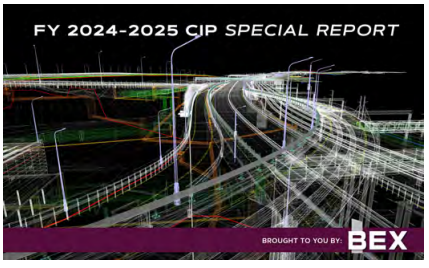
The catalyst for the Public Works Conference every year is the launch of the BEX annual CIP Special Report. This year’s edition—the FY 2024-2025 CIP Special Report—is the most detailed and expansive yet produced.
This year’s report was available for pick-up by early purchasers at the conference and includes line-item level project details from more than 30 of the largest agencies around the state.
Included in the purchase price is:
- A hardcopy of the 200-page-plus CIP Special Report,
- Digital files including the highlighted top projects in spreadsheet form,
- Department head contact information, and
- Prime design and contractor information.
The FY 2024-2025 CIP Special Report is available for purchase here.

